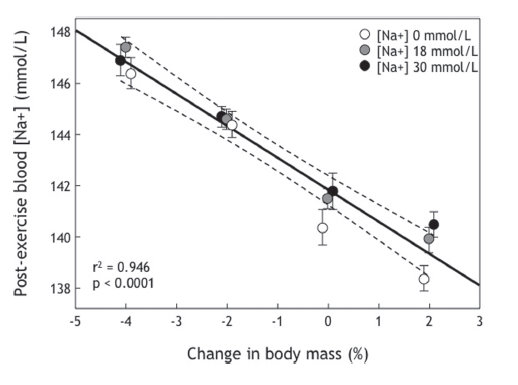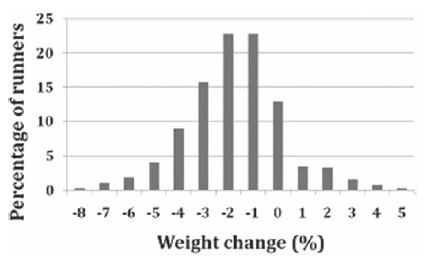THANK YOU FOR VISITING SWEATSCIENCE.COM!
As of September 2017, new Sweat Science columns are being published at www.outsideonline.com/sweatscience. Check out my bestselling new book on the science of endurance, ENDURE: Mind, Body, and the Curiously Elastic Limits of Human Performance, published in February 2018 with a foreword by Malcolm Gladwell.
- Alex Hutchinson (@sweatscience)
***
Neat study from some researchers in Greece, posted last month at Medicine & Science in Sports & Exercise, that suggests that the sensation of cool, wet water flowing down your throat may be more important than the actual hydration the water provides for helping athletic performance.
Hang on just a sec, you say. Doesn’t this sound a bit like the “mouth-rinsing” experiments that have caused such a stir over the past few years, where subjects get a boost from swishing some sports drink in their mouth and then spitting it out? Well, it’s similar… but different. The fluid in the mouth-rinsing experiments contains carbohydrate, and the evidence suggests (very strongly) that we have previously unknown carbohydrate sensors in our mouths. If you’re exercising at an intensity and duration where carbohydrate availability is a potential concern, then when your brain detects incoming carbohydrate, it lets you go faster/harder/farther — even if you then trick it by spitting the carbs out.
The new experiment only used water. They took 10 endurance-trained males, and put them through a two-hour dehydrating protocol (alternating cycling and walking in a heat chamber) that dehydrated them by 1.9% of their body mass. Then then did a ~20-minute cycle to exhaustion under one of three different conditions (each subject tried all three, separated by at least a week): either no water permitted at all, or 25 mL of water to drink every five minutes, or 25 mL of water to rinse their mouth and then spit out every five minutes.
Note that 25 mL is a very small amount of water — it works out to about 1.7 tablespoons. After 20 minutes, they’d have received a total of 100 mL, which weighs 100 grams. In comparison, the pre-test dehydration protocol had taken away about 1,500 grams on average.
The results: they lasted 17.7 minutes in the no-water condition, 18.7 minutes with the water rinse, and 21.9 minutes with water drinking. All the physiological measurements (heart rate, lactate) plus perceived exertion were the same between the groups at the end of the test:
[T]he efficacy of water suggests that probably the sensation of swallowing along with the cool sense in the digestive track can motivate moderate dehydrated subjects and lead to an increase in performance… There is evidence that drinking itself activates the oropharyngeal receptors which in turn, influence significantly fluid balance, thermoregulation and possibly exercise performance.
In other words, in addition to a carbohydrate warning system in the mouth, the brain also seems to gather information about incoming fluid from the throat. This makes sense: it allows us to adjust and moderate behaviour based on incoming fluid and energy rather than waiting for the fluid and energy to be processed and distributed throughout the body. But it leaves us susceptible to being tricked by sneaky scientists.
This isn’t the first time this idea has been investigated. The discussion section of the paper describes a really cool study:
Moreover, in a classic study published by Figaro and Mack, subjects performed three identical dehydration protocols followed by 75 min of rehydration consisting of 1) ad libitum drinking (control), 2) infusion of a similar volume of water directly into the stomach via a nasogastric tube (infusion) and 3) ad libitum drinking with simultaneous extraction of ingested fluid via a nasogastric tube (extraction). The researchers found reflex inhibition of AVP [vasopressin, a hormone that controls the regulation of fluids in the blood] and thirst in control and extraction but not during infusion, suggesting that oropharyngeal reflexes modulate thirst and the secretion of AVP.
Translation: this isn’t just a placebo effect. Drinking water by swallowing it down your throat tells your body that water is coming, and various systems throughout the body respond accordingly. If you’re rehydrated without swallowing, your body doesn’t realize the fluid is coming (at least not immediately), and doesn’t respond. And if you rehydrate by swallowing water but immediately have an equal amount of water sucked out your nose (is this a cool experiment, or what!), then your body still thinks it got rehydrated.
So what’s the message here? Well, it seems that rinsing and spitting doesn’t do everything. But the principle is the same: late in a race, when you don’t want to be downing a full bottle of anything, taking a few swallows of a drink can still trigger your carb response (in the mouth) and your hydration response (in the throat).

 What’s clear here is that how much you drink (which determines the change in body mass) is the dominant factor in where you sodium levels end up. If you drink enough to gain weight, your sodium levels are going to drop no matter how much sodium you ingest. There are some small differences between the drinks (which is why the three dots in each cluster aren’t right on top of each other), but they seem pretty minor. Even Baker, in her original paper, acknowledges this:
What’s clear here is that how much you drink (which determines the change in body mass) is the dominant factor in where you sodium levels end up. If you drink enough to gain weight, your sodium levels are going to drop no matter how much sodium you ingest. There are some small differences between the drinks (which is why the three dots in each cluster aren’t right on top of each other), but they seem pretty minor. Even Baker, in her original paper, acknowledges this:
